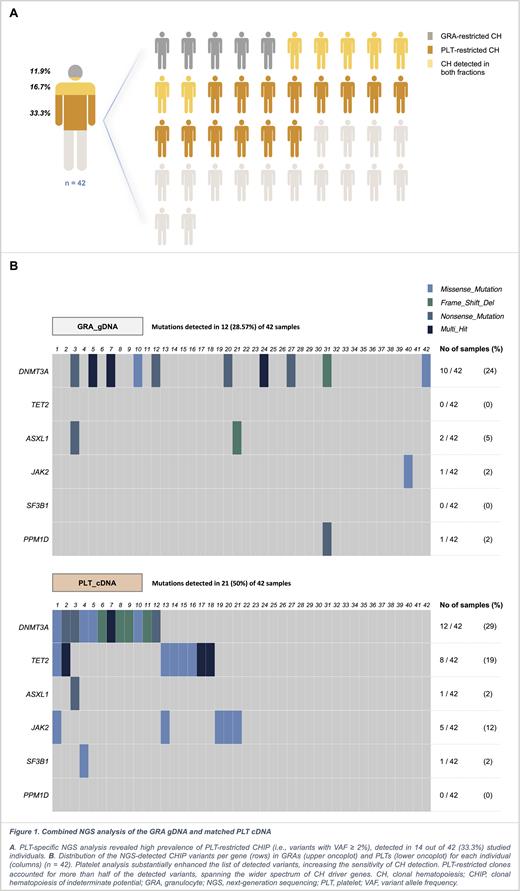Clonal hematopoiesis (CH) is a common age-related condition in which somatic mutations accumulate in hematopoietic stem cells (HSCs), leading to the clonal expansion of mutated cells. CH has been causatively linked with risk of disease, including atherosclerotic cardiovascular disease (CVD), and reduced overall survival. The current model of hematopoiesis suggests substantial heterogeneity and lineage-priming within the HSC compartment, including the existence of multipotent but platelet (PLT)-biased HSCs. However, all CH studies to date are based on whole blood or granulocyte (GRA) DNA, and therefore they do not assess for PLT-restricted clones, which we reasoned could be particularly important given the association of CH with CVD. We aimed to assess for presence of PLT-biased CH in a cohort of normal individuals, hypothesizing that PLT-biased CH might represent a distinct subgroup of persons with CH.
We analysed a cohort of 151 individuals, aged 22.0 to 98.6 years ( x̅ = 74.9; 95% CI, 50.0 to 91.8), with normal blood counts, and no known hematological malignancy. We first established a method for isolation of high-purity cDNA from PLTs alongside isolation of gDNA and cDNA from matched GRAs. Myeloid cell contamination was extremely low in the PLT fraction as assessed by flow cytometry and molecular analysis.
We first performed targeted analysis for presence of the JAK2V617F mutation in PLT and GRA fractions due to the known association of JAK2V617F with CVD and myeloid neoplasms, including essential thrombocythemia. We developed a high sensitivity allele specific JAK2V617F droplet digital PCR (ddPCR) assay (variant allele frequency [VAF] limit of detection 0.1%) for parallel assessment of gDNA and cDNA from GRAs and PLTs respectively. When including all cases with a VAF > 0.1%, JAK2V617F CH was detected in 21 (13.9%) individuals, consisting of 2 cases of non-lineage-restricted CH (present in both GRA and PLT fractions), 6 cases of GRA-restricted CH, and 13 cases of PLT-restricted CH. Only 6 cases showed VAF ≥ 2% (consistent with CH of indeterminate potential) and all were PLT restricted. Comparison of median JAK2V617F VAF in PLT cDNA with VAF in GRA gDNA revealed significantly higher VAF in the PLT-derived material (1.00% vs. 0.26%; p = 0.04).
We next developed a custom, targeted, hybridisation capture next-generation sequencing (NGS) panel for parallel ultra-deep sequencing of both gDNA and cDNA, covering the major genes and hotspot mutations involved in CH ( DNMT3A, TET2, ASXL1, IDH2, JAK2, CALR, MPL, CBL, KRAS, GNB1, SF3B1, SRSF2, U2AF1, PPM1D and TP53). The panel comprised a total of 250 120-nucleotide-long probes (including 27 cDNA-specific probes) with a combined footprint size 25,083 bp. Performance studies showed acceptable off-target effect and good coverage, alignment rate, uniformity, and complexity. Agreement between the NGS-measured VAF for GRA gDNA and GRA cDNA was high (ρ c = 0.952, alpha = 0.05). In total, we screened GRA gDNA and matched PLT cDNA samples from 42 individuals. At the resolution of VAF ≥ 2%, analysis of PLTs substantially enhanced the number of individuals with detected CH from 12 (28.6%) to 26 (61.9%) (Fig. 1). Amongst the detected variants (n = 44), mutations detected in the GRA fraction (n = 20) accounted for less than half of the detected variants, while the PLT fraction included ~75% of the variants (n = 33), including 55% (n = 24) that were PLT-restricted. Notably, lineage-restriction for the above variants held true when taking into consideration clones with VAF < 2% too. Median VAF for all CH variants was 3.9% (95% CI, 2.2% to 32.3%), with no difference between GRA and PLT CH. The detected variants were distributed across DNMT3A, TET2, ASXL1, JAK2, SF3B1, and PPM1D genes, with evidence of lineage bias towards PLTs for TET2- and JAK2-related CH. PLT-restricted clones included high-VAF (> 5%) variants in DNMT3A (n = 4; x̅VAF = 13.2%), TET2 (n = 2; x̅VAF = 7.7%), JAK2 (n = 2; x̅VAF = 21.6%), and SF3B1 (n = 1), including an individual with DNMT3AQ842R and the SF3B1K666N at VAFs 16.7% and 12.5% respectively. Selected NGS-detected variants were orthogonally validated.
We describe PLT-restricted CH as a frequent phenomenon in persons with normal blood parameters. Given the known association between CH and risk of CVD and hematological malignancy, further studies on larger patient cohorts are warranted to determine the importance of PLT vs. GRA CH in relation to clinical endpoints.
Disclosures
Sousos:University of Oxford: Patents & Royalties: 2203947.3 ; AOP Orphan Limited: Other: Educational travel grant. Murphy:University of Oxford: Patents & Royalties: 2203947.3 . Wen:AstraZeneca: Current Employment. Simoglou Karali:BMS: Research Funding. Shapiro:BMS: Research Funding; Roche: Speakers Bureau; Sobi: Honoraria, Speakers Bureau; CSL Behring: Speakers Bureau. Psaila:Novartis: Speakers Bureau; GSK: Honoraria; Blueprint Medicines: Honoraria; University of Oxford: Patents & Royalties: 2203947.3 . Mead:AbbVie: Consultancy, Other: investigator for AbbVie sponsored trials, Speakers Bureau; Celgene/BMS: Consultancy, Research Funding, Speakers Bureau; Sensyn: Consultancy, Speakers Bureau; Incyte: Consultancy, Speakers Bureau; Galecto: Consultancy, Research Funding, Speakers Bureau; Pfizer: Consultancy, Speakers Bureau; Gilead: Consultancy, Speakers Bureau; Alethiomics Ltd: Consultancy, Current equity holder in private company, Other: Cofounder & equity holder, Research Funding; Karyopharm: Consultancy, Speakers Bureau; Sierra Oncology: Consultancy, Speakers Bureau; CTI: Consultancy, Speakers Bureau; Novartis: Consultancy, Honoraria, Research Funding, Speakers Bureau; University of Oxford: Patents & Royalties: 2203947.3 ; Relay Therapeutics: Consultancy, Speakers Bureau; GSK: Consultancy, Speakers Bureau; Roche: Research Funding.


This feature is available to Subscribers Only
Sign In or Create an Account Close Modal